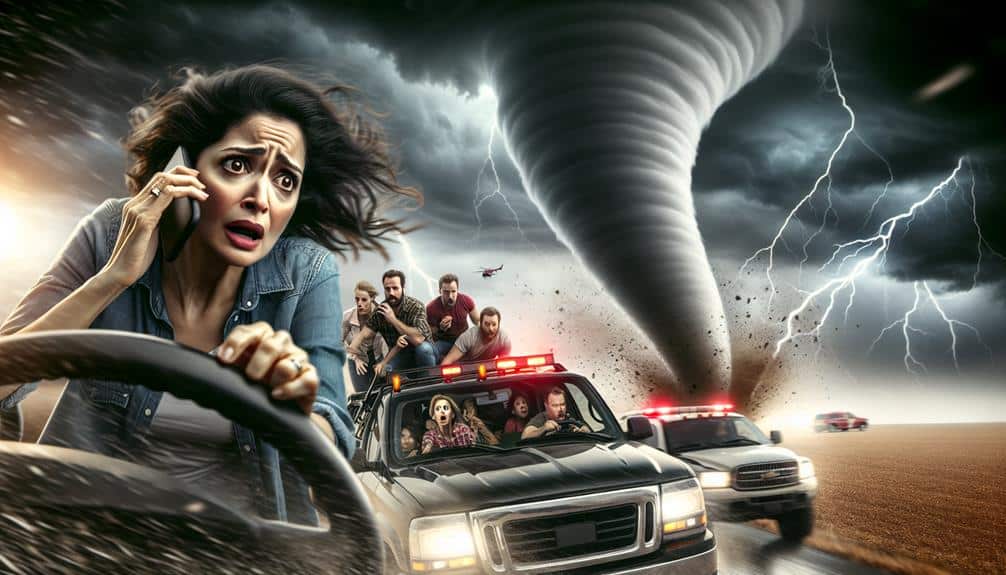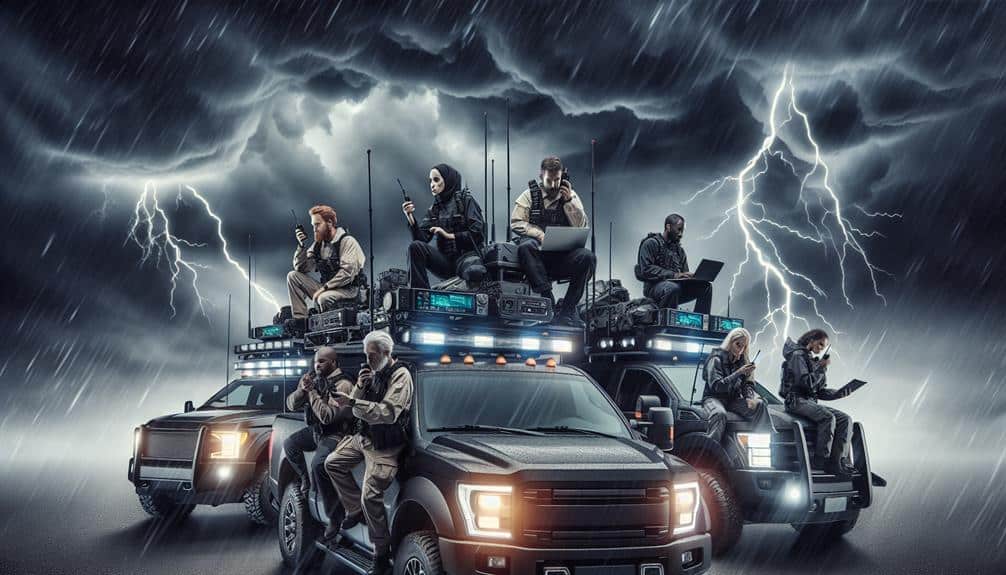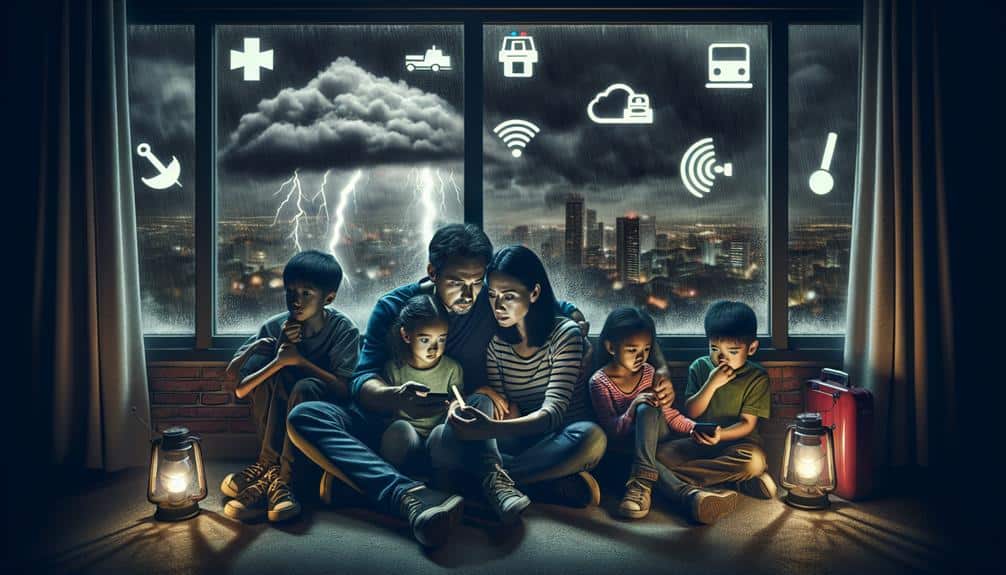In emergencies, our top communication strategies include establishing clear protocols so everyone knows their roles, using reliable tools like smartphones and two-way radios, and guaranteeing regular updates to keep everyone informed. We must work closely with local authorities for better coordination and prioritize simple, clear messaging. Training through realistic drills helps us prepare, and finally, we continually monitor and adjust our strategies based on real-time feedback. By following these steps, we can manage crises effectively and guaranteeing safety. Want to know more about securing effective communication during emergencies?
Key Points
- Establish clear protocols to ensure roles and responsibilities are understood and followed.
- Use reliable communication tools, including smartphones and two-way radios, with backup systems for redundancy.
- Provide regular updates to keep all stakeholders informed and maintain transparency.
- Coordinate closely with local authorities to leverage their expertise and resources.
Establish Clear Protocols
In the midst of an emergency, having clear procedures guarantees everyone knows their roles and responsibilities. We can't afford confusion when time is critical. By establishing and enforcing procedures, we guarantee that every team member knows exactly what to do, reducing chaos and improving the efficiency of our response.
Procedure enforcement is essential. We've got to make sure that everyone adheres to the established guidelines. This isn't about limiting freedom; it's about ensuring that every action taken is coordinated and effective. When we all follow the same playbook, we're stronger and more resilient.
Team communication plays a pivotal role. Clear procedures foster better communication among us. When everyone's on the same page, we can relay information more effectively and make quicker decisions. This unity is especially crucial during high-stress situations where every second counts.
Effective procedure enforcement and robust team communication are the backbone of our emergency response strategy. They provide the structure we need to act decisively and maintain our freedom to respond dynamically. By setting these procedures in advance and ensuring everyone understands and follows them, we maximize our chances of overcoming emergencies successfully.
Use Reliable Communication Tools
During emergencies, we must rely on dependable communication tools to guarantee our messages are received quickly and accurately. It's important to utilize technology that secures our emergency notifications reach the right people without delay.
Smartphones, two-way radios, and emergency alert systems offer vital connections during crises. These tools not only provide real-time updates but also allow for swift action and coordination.
We should prioritize platforms that are both resilient and user-friendly. Satellite phones, for instance, are invaluable when traditional networks fail. Similarly, apps designed for emergency communication can disseminate alerts and updates efficiently. By leveraging these technologies, we maintain a robust communication network even under the most challenging conditions.
Moreover, redundancy is key. We need backup systems to secure continuous communication. If our primary tool fails, having an alternative minimizes disruption. For instance, integrating SMS alerts with email notifications secures that critical information is always delivered.
In emergencies, the speed and reliability of our communication tools can make a significant difference. By utilizing technology effectively, we secure our emergency notifications are prompt and accurate, empowering us to respond swiftly and decisively.
Maintain Regular Updates
To keep everyone informed and aligned, we must provide regular updates throughout the emergency. Real-time updates are vital for maintaining stakeholder engagement and ensuring that everyone involved has the latest information. By doing so, we can manage the crisis more effectively and foster public trust.
Our crisis communication plan should include frequent, consistent updates that address the evolving situation. This involves not only sharing new developments but also reiterating key safety instructions and clarifying any misinformation. Timely updates help prevent confusion and reduce the spread of rumors, which can undermine our efforts and erode trust.
We need to utilize multiple communication channels to reach our audience. Social media, email alerts, and press releases are all effective tools for disseminating information quickly. By maintaining a steady flow of accurate information, we keep the public and other stakeholders engaged and reassured.
In times of crisis, transparency is paramount. Regular updates demonstrate our commitment to honesty and accountability, which are essential for maintaining public trust. By keeping everyone informed with real-time updates, we empower individuals to make informed decisions and take appropriate actions, ultimately contributing to a more effective emergency response.
Coordinate With Local Authorities
We also need to work closely with local authorities to guarantee a unified and effective response. By fostering solid community partnerships, we enhance our emergency response capabilities. Local authorities possess valuable knowledge about the area and its specific needs, making their involvement essential to maintaining public safety.
Collaboration guarantees that all parties are on the same page, preventing misinformation and confusion. We must establish clear lines of communication with local law enforcement, fire departments, and public health officials. Regular meetings and joint training exercises can help us build a cohesive emergency response plan that everyone understands and can execute efficiently.
Working with local authorities also means leveraging their resources and expertise. They can provide critical updates, manpower, and logistical support, which are indispensable during emergencies. When we coordinate effectively, we can deploy resources more strategically, cover more ground, and address issues as they arise in real-time.
In times of crisis, a fragmented approach can lead to delayed responses and increased risk to public safety. By prioritizing collaboration with local authorities, we guarantee a unified front, which ultimately empowers our community and upholds the freedom we all cherish.
Prioritize Message Clarity

We must prioritize message clarity to make sure everyone understands our communications during emergencies.
Using simple language, avoiding jargon, and providing clear instructions are essential.
Let's focus on these strategies to enhance our effectiveness.
Use Simple Language
In the midst of an emergency, it's important to convey information using simple language to make certain everyone understands the message clearly. When we prioritize clear communication, we facilitate a more effective response. Simplified messaging guarantees that people can grasp the critical information quickly, allowing them to take immediate and appropriate action.
We need to remember that during crises, stress levels are high and cognitive loads are heavy. Using simple language cuts through the noise and confusion, helping us to reach everyone, regardless of their background or education level. Our goal is quick understanding, and by eliminating complex phrases and technical terms, we make our messages accessible to all.
Straightforward language isn't just about being understood; it's about empowering people to make informed decisions. When we communicate simply and directly, we minimize the risk of misinterpretation and maximize the speed of response. In these moments, every second counts, and clear instructions can be the difference between safety and disaster.
Let's commit to using simple language in our emergency communications. By doing so, we enable a more effective and unified response, guaranteeing that everyone has the information they need to stay safe and make the best choices.
Avoid Jargon Terms
Eliminating technical terms ensures that our messages are clear and easily understood during emergencies. When we simplify information, we make sure that everyone, regardless of their background or familiarity with specific terminology, can grasp what we're communicating. This is important when every second counts and there's no room for misunderstanding.
Jargon often leads to confusion, which can be harmful in high-pressure situations. To prioritize message clarity, we need to simplify our language and focus on delivering straightforward, concise instructions. Here are some key points to remember:
- Use common words: Replace technical terms with everyday language that everyone can understand.
- Be direct: Get straight to the point to avoid any ambiguity or misinterpretation.
Provide Clear Instructions
Clear instructions save lives during emergencies by ensuring everyone knows exactly what actions to take. When we communicate effectively, we eliminate confusion and enable people to follow emergency protocols efficiently. Our top priority should be to convey messages that are simple, direct, and actionable.
We can't afford ambiguity in high-stress situations. Let's use plain language and avoid unnecessary details that could cloud understanding. Each instruction should be brief yet thorough, guiding individuals step-by-step through what they need to do.
For example, instead of saying 'evacuate the area,' we should specify, 'Exit through the nearest door and proceed to the parking lot.'
Effective communication also involves repeating key points and using multiple channels. Whether it's through loudspeakers, text alerts, or social media, consistent messaging helps reinforce the actions people need to take.
Train for Emergency Scenarios
Effective emergency communication hinges on regular, realistic training scenarios that prepare everyone for the unexpected. We can't afford to be caught off-guard when emergencies strike. That's why scenario simulations and team drills are essential. These exercises help us identify potential weaknesses and improve our response times.
Let's break down why training is pivotal:
- Realistic Scenario Simulations: By practicing with realistic scenarios, we can better anticipate challenges and refine our communication strategies. These simulations expose gaps in our plans and allow us to address them before an actual emergency occurs.
- Team Drills: Regular team drills ensure everyone knows their roles and responsibilities. When each team member understands their tasks and how they fit into the larger response effort, we can act swiftly and cohesively. Drills also build trust and coordination among team members, which is crucial during high-stress situations.
Incorporating these elements into our emergency preparedness plan helps us stay agile and ready for any crisis, ensuring that our communication remains clear and effective.
Monitor and Adjust Strategies

We must regularly evaluate and adjust our communication strategies to maintain their effectiveness during emergencies. It's not enough to have a plan; we need to make sure it works in real-time. By continuously monitoring our strategies, we can identify what's working and what isn't. This proactive approach allows us to adapt strategies quickly, keeping our communication clear and effective.
Feedback is vital. We should gather input from all stakeholders, including emergency responders and the affected community. This helps us understand how our messages are received and where improvements are needed. Regular debriefings and after-action reviews enable us to refine our methods based on actual experiences.
Technology also plays a significant role. We must stay informed about new tools and platforms that can enhance our communication efforts. Leveraging real-time data and analytics helps us evaluate effectiveness and make informed decisions swiftly.
In the face of an emergency, flexibility is our ally. By remaining adaptable, we guarantee that our communication strategies can evolve as the situation unfolds. This not only maximizes our response efficiency but also empowers those we aim to protect, fostering a sense of control and resilience in uncertain times.
Frequently Asked Questions
How Can Social Media Be Effectively Used for Emergency Communication?
Imagine social media as our lifeline during crises. For effective crisis management, we should leverage online platforms to disseminate timely updates, debunk misinformation, and engage communities, ensuring everyone stays informed and connected.
What Role Do Non-Verbal Cues Play During Emergency Communication?
Non-verbal cues are essential in emergencies. Our body language and eye contact can convey urgency, trust, and clarity, ensuring swift, effective action. Let's harness these tools to communicate under pressure and safeguard our freedom.
How Can Psychological Support Be Incorporated Into Emergency Communication Plans?
Studies show that 67% of individuals benefit from crisis counseling during emergencies. We must integrate emotional support into our plans, ensuring mental health professionals offer immediate assistance to those affected, promoting resilience and recovery.
What Are the Best Practices for Multilingual Communication During Emergencies?
We must address language barriers and cultural sensitivity by using translation services and community outreach. Prioritizing clear, multilingual communication guarantees everyone's safety and empowers communities to act freely during emergencies.
How Can Remote Teams Coordinate Effectively During an Emergency?
We can coordinate effectively during an emergency by conducting virtual training regularly and scheduling frequent team check-ins. This guarantees everyone stays informed and aligned, enhancing our ability to respond promptly and efficiently, no matter the situation.


